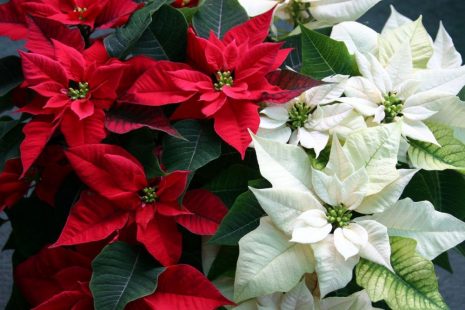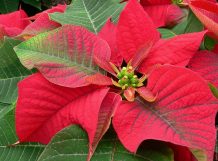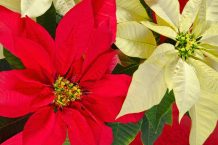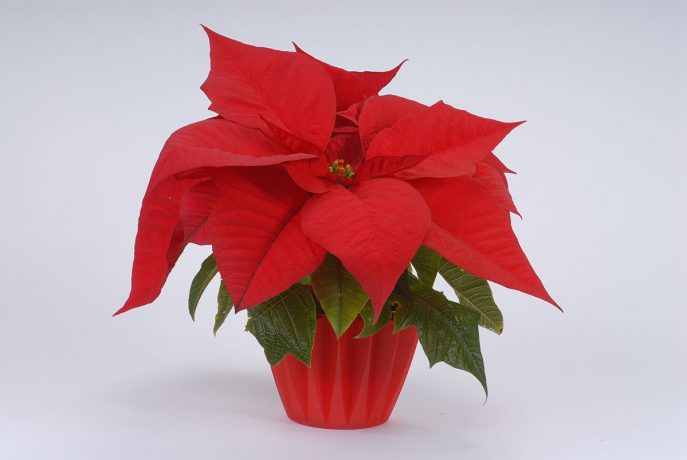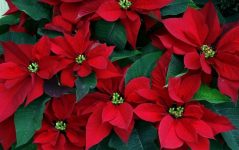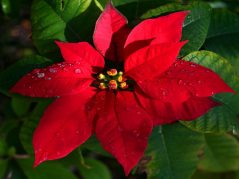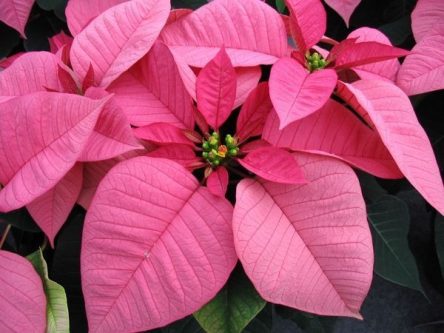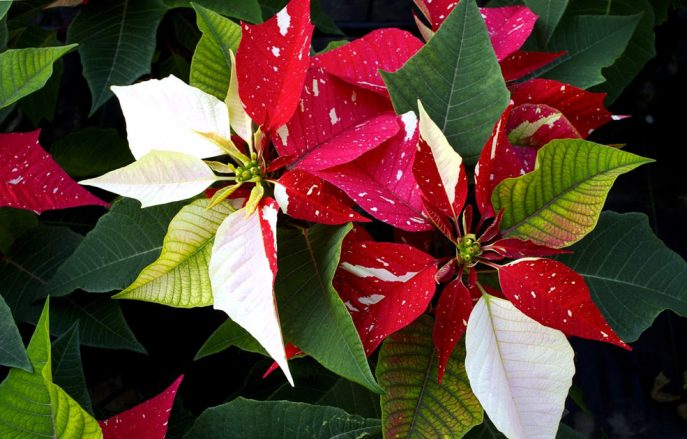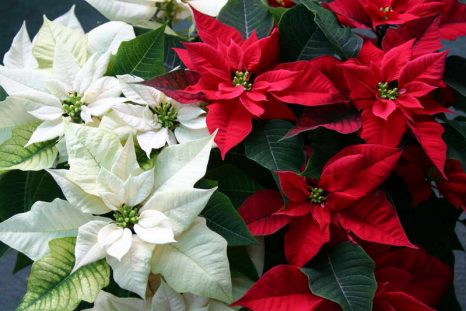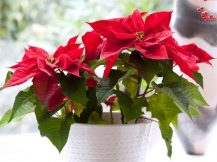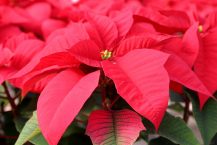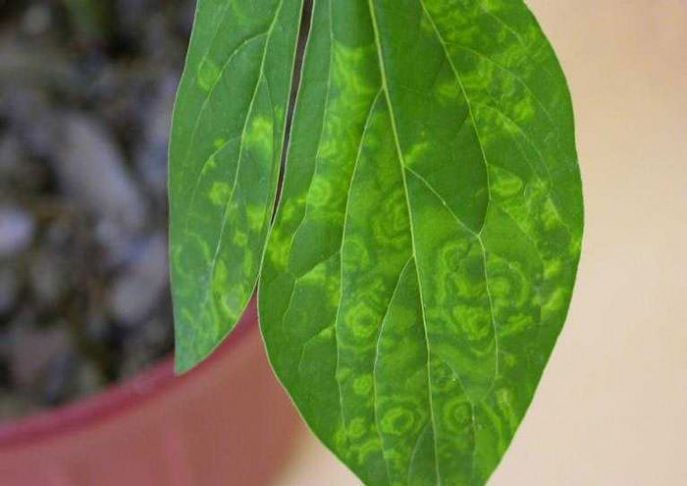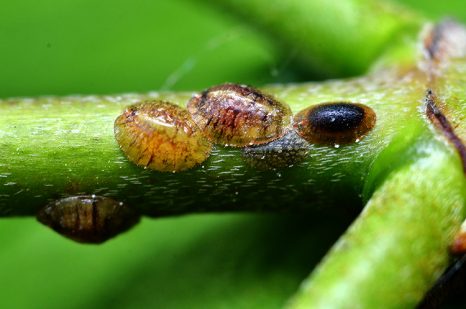Poinsettia, which is easy to care for at home, pleases with beautiful flowering for Christmas. Its large bright flowers are actually mutated leaves, which are called bracts, real inflorescences are small and yellowish, it is difficult to immediately notice.
Poinsettia or euphorbia is a beautiful native of Mexico, a plant of the Euphorbia family. In a warm climate, it is an evergreen shrub up to 3 m in height with large dark green leaves, indoor varieties are miniature.
Material Content:
Types and varieties of flower
Poinsettia has been grown as an ornamental plant since the 19th century, hybrid varieties are bred, the variety of colors of which is amazing. Popular varieties of poinsettia or beautiful milkweed, with the coloring of bracts:
- cream - Cortes White;
- fiery - Cortes Faye;
- white - Friedum White;
- scarlet - Fridum;
- red - Goldfinge;
- bright red with veins - Juste Red;
- pale pink with a white border - Mablesta;
- compact hot pink - Pink Al;
- white with green veins - Regina;
- pink-violet, with a strongly cut white edge - Struberi and cram.
Some varieties of poinsettia have bracts of an unusual shape. British breeders developed the Winter Rose variety, which, during flowering, resembles a rose bush.
Poinsettia: cultivation features
After flowering, poinsettia drops its leaves and loses its decorative appearance, there comes a time of rest. Some inexperienced gardeners may throw the plant away, thinking that it is gone, but it is not. If you show a little patience, by Christmas the beautiful euphorbia will blossom, like the "Star of Bethlehem" in the night sky.
When the flowering ends, the poinsettia is cut off, leaving the trunk 10-15 cm high, and watering is reduced.The pot with the plant is placed in a cool place with moderate lighting.
In May, the flower is transshipped into a pot with fresh soil, without shaking the ground from the roots. They put in a well-lit place, increase watering and introduce fertilizing.
Home Care
This beautiful plant is a bit capricious, like all beauties. It belongs to succulents, but does not like drying out of the soil, and in the absence of watering it begins to drop leaves. Poinsettia flower is photophilous, in low light begins to turn yellow. He needs top dressing, an annual transplant, does not like drafts, sudden changes in temperature and too dry air. If you understand what a plant needs, caring for it is easy.
Soil requirements
Soil mix for poinsettia can be prepared independently. To do this, take 1 part of sand, sheet, turf and peat land. At the bottom of the pot put good drainage. You can buy ready-made land for succulent plants in a flower shop. It will be light enough, permeable to water and nutritious.
Temperature, humidity and lighting
Poinsettia loves good lighting, and grows best near south or southeast windows. She especially needs a lot of light in the summer, during the active development and laying of flower buds. To flowers bloomed by Christmas, it is recommended that from the end of September, cover the plant with a paper or dark plastic bag, and remove it in the morning. Poinsettia should be in the dark for at least 14 hours. If this is not done, it will bloom anyway, but by the end of winter.
The air temperature in the room where the most beautiful euphorbia grows, should not fall below 10 degrees, the optimal middle - from 16 to 22 degrees. The plant prefers moist air, but with increased humidity and low temperature it can get a fungal disease.
Watering a flower
Watering poinsettia depends on the time of year. After flowering, it is reduced to a minimum, they are monitored only so that the earthen lump does not dry out much. And in May, after transplanting, the plant should be regularly watered, but it is undesirable to overdo it so that the roots do not rot.
You can not use cold water, the topsoil should dry before the next watering. It is important that the water is “live” - spring or well-maintained urban water of good quality, passed through a special filter.
Fertilizer and fertilizer
They feed the plant in summer and autumn, twice a month, using fertilizers for indoor flowers. Since May, universal fertilizers have been used for decorative and deciduous plant species. They should contain phosphorus, nitrogen, potassium and trace elements. You can use organic-based liquid subcortex, such as Magic Mix.
From the end of August, poinsettia begins to be fed once every two weeks with fertilizers for decorative flowering plants, in which potassium predominates. During flowering and after it, top dressing is stopped.
Pruning and transplanting
To form a bush, use pinching and pruning. It is especially important to do it if you have a large variety of poinsettia growing on a personal plot. But such a miracle is possible only in a tropical climate, where there is no winter frost.
Old shoots are pruned at the end of winter so that new ones grow more branched. In spring and early summer, they pinch young shoots, this will help the plant to form many flowers. Finish nipping and pruning in August, and no longer touch the flower until spring. At the end of summer, flower buds begin to open, which will open by Christmas.
Poinsettia propagation
For propagation, cuttings cut in spring or summer are used. An incision is made under the node, leaving at least five internodes. Before placing the stem on rooting in the ground, the lower leaves are torn off and the milky juice released from the stem is washed off. Then the twig is placed in a small pot with well-moistened sand or other light soil, and covered with a transparent plastic bag.
The plant is placed in a warm, well-lit place, moisturized as necessary. When the stalk is rooted, it will be visible at the beginning of its growth, the package can be removed and the top attached.Transplant poinsettia into a pot with a diameter of 7 cm, with a normal soil mixture is better after 2 months.
Pest and Disease Control
The cause of plant diseases can be errors in care, viruses, fungi or insect pests. Here is a list of some diseases and measures to combat them:
- Mosaic virus - a light mosaic pattern appears on the leaves, the plant stops growing and is deformed. It is impossible to cure a flower; it is destroyed so that other plants do not get sick.
- Late blight - a fungal disease that affects the entire plant, the roots begin to rot, become soft, the leaves turn yellow and fall off. For treatment, fungicides Ridomil Gold or Allette are used. The leaves are sprayed, the roots are treated, the rotten ones are trimmed, and the flower is transplanted to a new land.
- Flower thrips - these insects leave small punctures on the leaves, around which the leaf plate is bent and twisted. For the fight using insecticides - Fitoverm, Actellik, Fufanon. With severe damage to the flower, the treatment is repeated.
- Scale, mealybugs - white tubercles are visible on the leaves or stems, the plant stops growing. For the fight using insecticides - mineral oils M-30, M-50 or Actaru and Fitoverm.
In addition, poinsettia can be affected by various rot, whiteflies, aphids, and larvae of mushroom mosquitoes. Dry leaves, temperature changes, too plentiful or insufficient watering, lack of top dressing leads to yellowing of the foliage and its uneven coloring.


